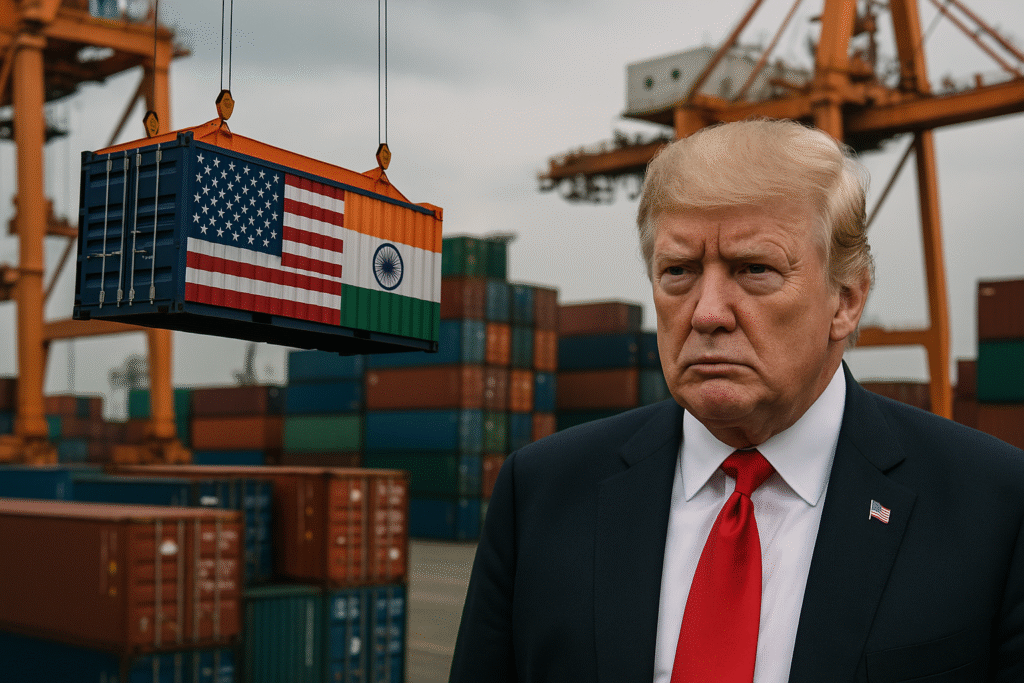
Former US President Donald Trump’s recently imposed tariffs on Indian exports are reshaping one of the world’s most important trade relations. Since these trade policies are effective, they have an immediate effect on industry, market, and geopolitical alliances. India now faces a complex route under new import duties, economic reconstruction, and increasing diplomatic pressure.
A New Reality: Khadi Tariff is Introduced
In early August 2025, Trump issued a 25 per cent mutual tariff on Indian goods exported to the United States, citing India’s trade surplus, non-tariff barriers, and imports released from Russia. A few weeks later, he doubled the total tariff to 50 per cent on almost all Indian exports, marking one of the fastest trade punishments on a major trading partner.
These tricks affect exports of more than $80 billion – about 17 per cent of India’s GDP. Industries such as textiles, gems and jewellery, electronics, auto parts, and agricultural products felt the immediate brunt. This pressure came at a time when India was struggling with the value of the rising rupee and the concerns of inflation.
Regional Impact: Clothing to Agriculture
Why is this thing? India’s labour-intensive export areas are a major highlight. Textile and apparel exporters, especially from major hubs like Punjab, faced order cancellations worth more than ₹ 1 lakh crore, as the cost competition fell rapidly. Gems and jewellery exporters fought, while electronics and machinery manufacturers faced new price obstacles.
Agricultural exports, rice (especially basmati), cashews, and buffalo meat – reduced low demand, as tariffs pushed Indian prices more than major rivals like Thailand, Pakistan, Vietnam, and Ecuador. Small-scale processors of traditional snacks and export-orientated spices felt immediate stress.
Meanwhile, several major auto components, including Tata Motors and Bharat Forge, due to the inflated costs, reported U.S. orders. The IT service sector remained untouched by tariffs, but officials warned that the recession in the US economic development could indirectly hurt long-term demand.
Macroeconomic Replies: Growth, Market, and Currency
Economists estimated a GDP growth of 10 to 40 basis points, with a nominal growth reduced from 6.5 per cent to just 6 per cent, if the tariffs continue through 2026. The National Institute for Public Finance and Policy estimated the direct export deficit at $14 billion.
After the announcements, equity markets were rapidly opened. Nifty50 fell nearly one per cent before recovery, and India’s ETF lost a week-long streak. Foreign institutional investors drew more than $2 billion in July, damaging the spirit. In parallel, the rupee depreciated about 2 per cent to reach record highs and inflation concerns against the dollar.
India’s Strategic Reaction: Diversification and Diplomacy
India is still not sitting. New Delhi entered the immediate trade talks with Washington and offered to reduce tariffs on American imports in areas such as defence and energy. It was discussed to cut import duties on US goods worth $23 billion, which was expected to end the deadlock. At the same time, the Ministry of Finance and Agriculture leaders urged exporters to diversify alternative markets in the Middle East, Africa, ASEAN, and Europe so that U.S. dependence can be reduced.
Despite the pressure, specialists argue that India retains a competitive advantage; maximum rival exporters like China, Vietnam, and Bangladesh also face extra American tariffs from time to time, more than 45 per cent, which makes the Indian items less expensive. Economic companies like Moody’s highlighted India’s huge home market and occasional dependence on exports as strengths, offering flexibility towards international shocks.
Stress and Diplomacy: Political Collapse
Business tension quickly increased into widespread diplomatic friction. Once a hot, “Mission 500” partnership between “Mission 500” leaders increased bilateral trade by $500 billion by 2030. India condemned Trump’s punitive tariffs as inappropriate and powerful, including its Russian oil imports and criticisms. Meanwhile, Trump cultivated close ties with India’s rival Pakistan and extended a strategic alarm in New Delhi.
Long-Term Implications and Opportunities
Further, high tariffs can reopen global supply chains—if new business patterns emerge that are in favour of India. Miscellaneous export markets, strengthened domestic manufacturing, and better infrastructure. In addition, business pain can accelerate exports of services as temporarily encountered goods. Indian industry analysts promise to focus on automation-intensive export segments, renewable energy supply, and premium agricultural products.
At the same time, risk remains: currency depreciation stops frequent inflation, preventing foreign investment, and continuous trade friction may reduce India’s recovery. Political uncertainty in the US and its electoral cycles can make dialogue more complex.
Final Thoughts
25% of Trump’s 25% – and later on, Indian exports are a decisive moment in the US-India trade relations. Clothing, agriculture, auto components, and more far sectors now have to face sharp failures. Economic indicators immediately reveal the forecast of market shocks and slow growth. Nevertheless, India’s export power offers cushions against long-term loss relative to regional peers, domestic demand, and fast diplomats.
The coming months will test whether India can customise the trade strategy, bring diversity to the export markets, and at home, develop and protect jobs, and provide all meaningful business relief. As uncertainty persists, businesses and policymakers should equally act decisively to navigate this geopolitical-economic intersection.

